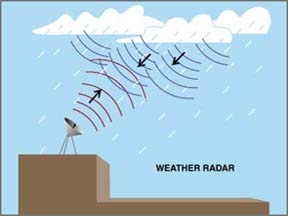Weather instruments are mounted on the top of the Great Blue Hill Weather Observatory in Milton, MA.
Click on image for full size
Image courtesy of Wikipedia Creative Commons
Weather Instruments
Knowing what weather is on the way is important to many people. For example, farmers plan their planting schedule based on the upcoming weather. They might not want to plant seeds right before a heavy rainstorm or a night with temperatures below freezing. Forecasts are also important for human safety. When people know that a hurricane or tornado is in the forecast they can take appropriate measures to ensure their safety. People also plan their leisure time based on the weather forecast.
In order to predict the weather, meteorologists constantly gather information about weather conditions everywhere on Earth. This information is collected using specialized equipment. A barometer measures atmospheric pressure, a thermometer measures the temperature, and an anemometer measures wind speed and direction. Weather radar detects precipitation in the clouds, and the Doppler radar takes measurements of winds in clouds in order to predict severe storms and tornadoes. All of these measurements help scientists make an accurate weather forecast.
Weather stations often contain the different weather instruments listed above to collect data. In addition, scientists launch weather balloons to collect data from the atmosphere. Research aircraft also carry instruments to collect data about weather and climate.
You might also be interested in:

Rain is precipitation that falls to the Earth in drops of 5mm or more in diameter according to the US National Weather Service. Virga is rain that evaporates before reaching the ground. Raindrops form
...more
As a strong hurricane heads towards the coast, people prepare - boarding up houses, packing the car, and evacuating. These storms can spell disaster for people in hurricane prone areas, so they are taken
...more
A barometer is a weather instrument used to measure atmospheric pressure. The first barometer was invented in 1643 by Evangelista Torricelli, one of Galileo's assistants. This first barometer used mercury
...more
Thermometers measure temperature. "Thermo" means heat and "meter" means to measure. You can use a thermometer to measure the temperature of many things, including the temperature of
...more
An anemometer is a weather instrument used to measure the wind (it can also be called a wind gauge). Anemometers can measure wind speed, wind direction, and other information like the largest gust of wind
...more
Wind is moving air. Warm air rises, and cool air comes in to take its place. This movement creates different pressures in the atmosphere which creates the winds around the globe. Since the Earth spins,
...more
Radar is important to weather forecasters because it can detect rain and hail. The radar bounces radio waves off water particles in clouds. A computer measures how long it takes for the radio waves to
...more















